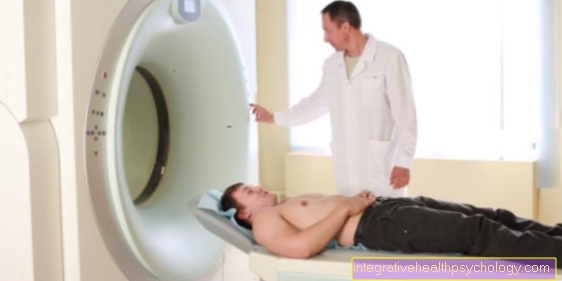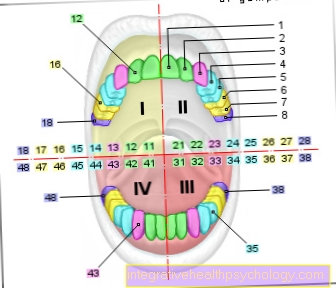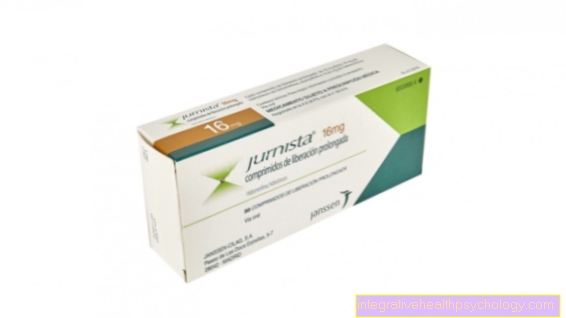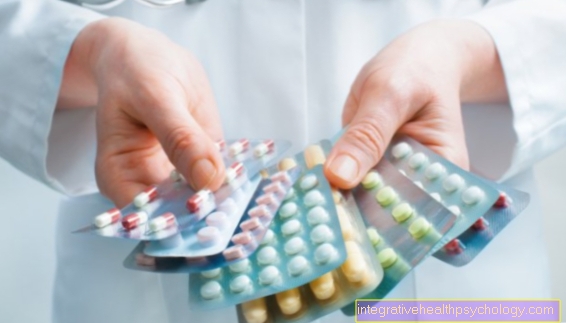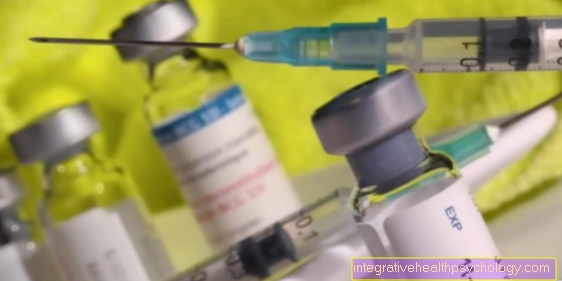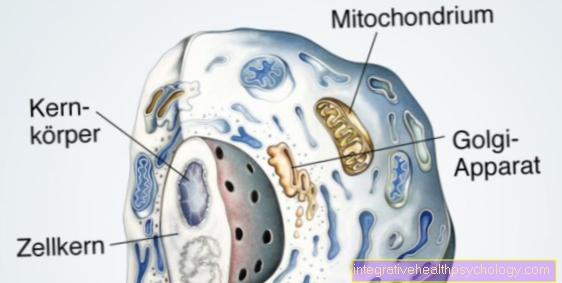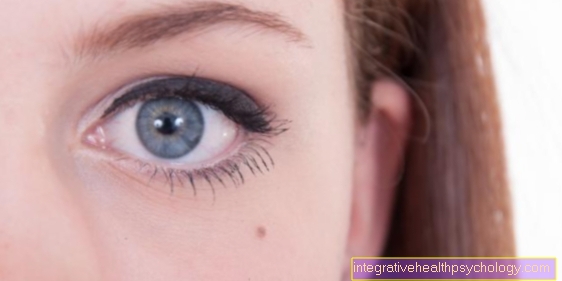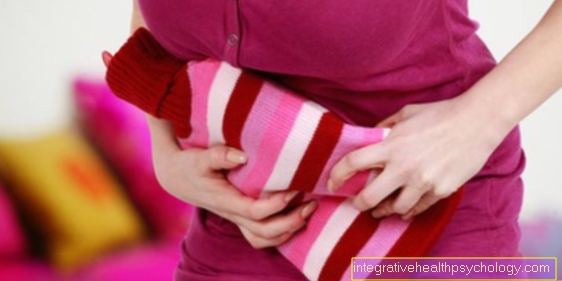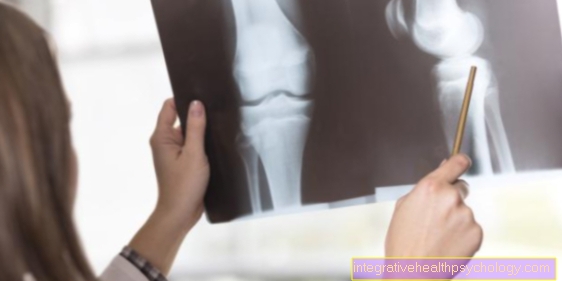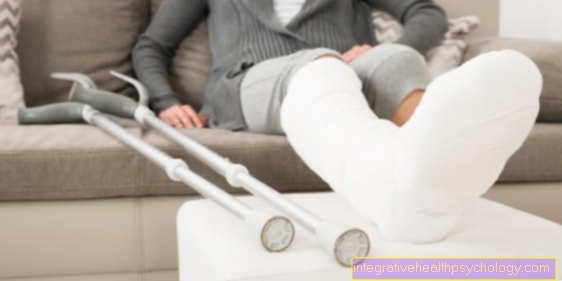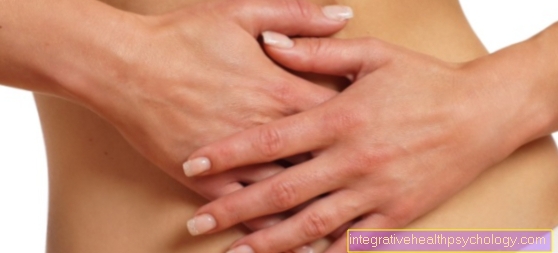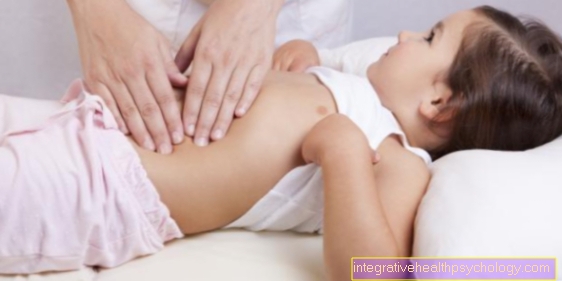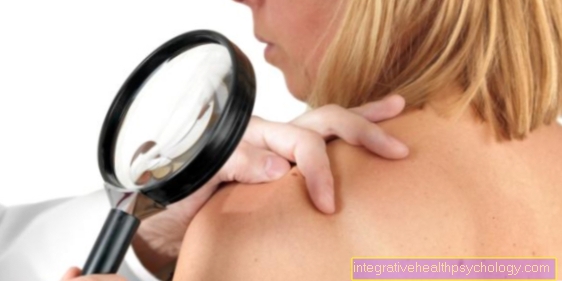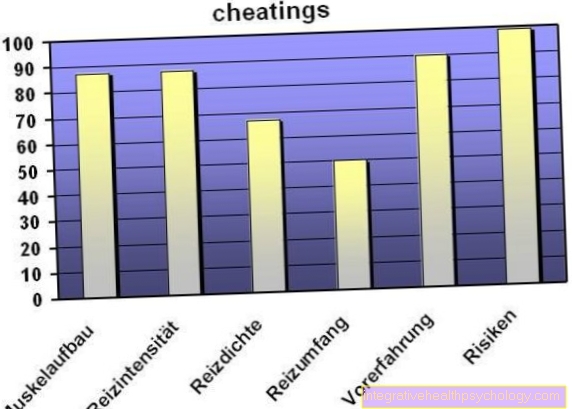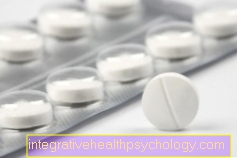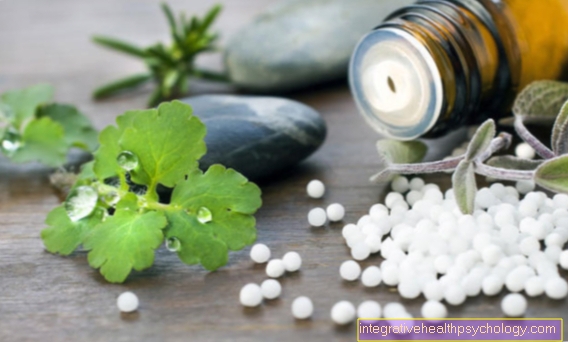Pain after vaccination
introduction
Pain after vaccination is very common. Usually only the area around the puncture site hurts. There may also be redness and swelling there. These signs indicate that the body's immune system is dealing with the vaccine. These local reactions are usually not cause for concern and will go away on their own within a few days after vaccination.

causes
There are two different types of vaccines - live and dead vaccines. With live vaccines (for example measles, mumps and rubella vaccine), live pathogens are injected into the body in a weakened form. In the case of dead vaccines (e.g. flu vaccination, rabies vaccination), the pathogens are completely killed beforehand and only immunoactive fragments of the pathogen are injected into the body. In the case of dead vaccines, the poison of certain pathogens can also be applied in a modified form. One then speaks of a toxoid vaccine. Examples are the tetanus and diphtheria vaccinations. However, all vaccines have in common that they activate the immune system and lead to antibody production. In this way, the patient should already be prepared for a possible real infection and thus be able to ward off the disease.
If a vaccine is now injected into the arm, the body is already dealing with the introduced particles at this point. The vaccination site may swell, redden, and pain. This reaction is therefore quite desirable and only indicates that the body is reacting to the vaccine. Serious and dangerous reactions to vaccinations, however, are very rare. Some vaccines also contain additives that strengthen the body's immune response and are supposed to attract even more immune cells to the site of the puncture site. These additives are called adjuvants. However, they can irritate the tissue and cause pain as well. Live vaccines often experience less pain than dead vaccines, as live vaccines contain fewer or no adjuvants. Otherwise, these would impair the effectiveness of the live vaccine.
Concomitant symptoms

Pain after vaccination can usually be compared with sore muscles in the vaccinated muscle. Since most of the vaccinations nowadays are in the upper arm, it is usually the Deltoid muscle affected. Movement with the arm can be painful for several days, especially if the arm is to be raised to the side. In addition, redness and / or swelling of the puncture site may occur.
Some people also react to vaccinations with tiredness, fatigue or even a fever. Body aches and headaches are also possible symptoms. This indicates the immune system's response to the vaccine. Usually these symptoms are harmless and go away within a few days after vaccination. Not everyone reacts this way to a vaccination. Even if there are no symptoms, the vaccination can be assumed to be effective. Everyone reacts differently to the substances introduced. Serious vaccine reactions are very rare. If the vaccinated arm swells severely or if a high fever and / or shortness of breath occurs following a vaccination, a doctor should be consulted immediately.
Pain and fever after vaccination
Especially in children, pain after vaccination often occurs in combination with a fever. The fever indicates the (desired) reaction of the immune system to the vaccination and usually goes away after a day or a few. In the case of fever and pain after vaccination, the child can be given antipyretic drugs.
However, if the fever is unusually high or if it lasts for a long time, a doctor should be consulted again and the previous vaccination should be reported. In rare cases it is possible that the fever triggers a febrile seizure. Parents of children who have already been affected should start lowering the fever early on if they have a fever after vaccination.
It may be possible to give an antipyretic drug prophylactically. However, this must be discussed with the treating pediatrician.
Even adults can develop a fever and pain after vaccination. Pain can be perceived in the form of local pain at the injection site, but also as generalized limb or muscle pain. In both cases it is important to take some physical care in the first time after the vaccination. Adults can also take antipyretic medication for fever and pain.
Learn more at:
- Fever in baby after vaccination
- Fever after vaccination in an adult
- Vaccination side effects
Pain and redness after vaccination
A reddened and often swollen injection site is one of the most common local vaccination reactions. This reddening is often associated with pain, similar to the pain associated with sore muscles. This response to vaccination is harmless and indicates the desired response of the immune system to the dose of vaccine given. Most of the time, the pain and redness disappear completely after one to three days. Temporary cooling can also help.
Diagnosis
It is very easy to diagnose pain after vaccination. The symptoms and their timing after vaccination are very typical and usually harmless. At inspection The puncture site may show redness and swelling. Further diagnostics are usually not required.
therapy
Pain after a vaccination does not usually require therapy. The arm should be temporarily exposed to as little weight as possible. The cooling the puncture site can relieve the pain. If the symptoms are more severe, a Painkiller be taken. If there is a pronounced vaccination reaction with severe swelling, a rash all over the body, swelling in the face area and / or shortness of breath, a doctor should be consulted immediately. This then decides what needs to be done further.
homeopathy
Various remedies are recommended in homeopathy that can be used to treat vaccine reactions, for example Thuja. However, since these are usually harmless vaccination reactions, if a vaccination reaction occurs at all, they generally do not require any therapy. The prophylactic administration of homeopathic remedies before vaccination is therefore questionable. If you want to treat stronger vaccination reactions after a vaccination homeopathically, different preparations can be used depending on the symptoms, for example Silicea, Belladonna, Aconite, Mercury or Sulfur. However, therapy should be stopped by an experienced homeopath. Self-medication is to be avoided.
Cold or heat if there is pain after vaccination
It is advisable to cool the area, especially if pain is combined with swelling and redness around the injection site. Cooling can relieve pain and reduce swelling. However, especially with children, only a cooling pad from the refrigerator and not from the freezer compartment should be used for cooling. This should then be on the affected area for a maximum of ten minutes at a time so as not to overcool it.
forecast
The forecast of pain after vaccinations is very good. The symptoms usually go away on their own within three days after the vaccination. Cooling measures and the temporary Immobilization of the arm can help.
How long does pain last after the vaccination?
Post-vaccination pain usually only lasts for a few days. For most people, they go away after three days at the latest. In a few cases the pain can drag on for a long time, but after a few days a clear improvement in the symptoms should be noticeable.
When can I do sports again if I have pain after the vaccination?
Slight pain around the injection site and in the affected muscle is one of the most common side effects after a vaccination.
As a general rule, heavy physical activity should be avoided if possible on the day of vaccination. Especially when pain has occurred, the person affected should wait until it has subsided.
This is usually the case after a day or a few. Sports activities can then be resumed. However, if the pain does not subside after a few days or if it even worsens, you will need to visit your doctor again.
You might also be interested in this topic: Is it allowed to do sport after a vaccination?
Prophylaxis / Avoidance
Pain after vaccination cannot always be avoided because the symptoms are triggered by the reaction of the immune system to the vaccine as well as by additives added to the vaccine. However, to keep the pain as low as possible, it is recommended to let your arm hang loosely during the vaccination and not to strain. The vaccination itself will then be less painful.
Afterwards, the arm should if possible little moved become.
Sport or other strenuous activities should be avoided on the day of the vaccination so that the body has enough time and rest to deal with the vaccine.
You can also put an ice pack on the vaccination site after the vaccination. This can relieve pain and also has a decongestant effect. You should make sure that the arm is not cooled down too much. Otherwise frostbite can occur.
Pain after vaccination in the baby / infant

Babies up to 18 months of age are not placed in the upper arm, but in a thigh muscle (Vastus lateralis muscle) vaccinated. The upper arm muscles are not yet sufficiently developed at this age. Nowadays, the buttocks are no longer vaccinated because the resorption of the vaccine is too uncertain there and the effectiveness of the vaccination is therefore not guaranteed enough. Babies usually cry when they are vaccinated because they are unlikely to get the bite. They also develop the same vaccination reactions as adults, which means that the puncture site can last for a few days Pain prepare. It is estimated that such vaccine reactions occur in 10% of vaccinated infants. However, the pain should subside after a few days. If the puncture site changes, becomes severely swollen, or if the baby develops a rash or shortness of breath, it is important to see a doctor.
Pain after vaccination in the child
Post-vaccination pain in children usually occurs above the injection site. Often reddening and swelling in this area occur at the same time. The pain occurs after two to three days and goes away just as quickly on its own. Such pain is not to be seen as a vaccination complication, but rather as a natural vaccination reaction. A vaccine is presented to the child's immune system and begins to work against it in order to produce suitable antibodies for protection. This can then lead to a local reaction at the injection point.
In some cases, in addition to the local reaction, there is a general reaction of the body to the vaccine. The children can then complain of headaches and pain in their limbs. In addition, there is usually a general malaise and a slight increase in temperature. Since small children in particular are not yet able to localize pain correctly, children usually complain of abdominal pain. This can also happen after vaccination. If the lymph nodes in the abdomen swell as an immune reaction, this can also cause abdominal pain. The pain that occurs in the course of a vaccination can all be classified as harmless and disappears on its own after a short time. It is important to keep the pain as low as possible during vaccination for children. Correspondingly, many strategies have been developed by paediatricians to keep the stress for the child as low as possible during vaccination.
You can find more information on our main page: Vaccination
Arm / shoulder pain
From the age of 18 months, children and adults are usually vaccinated in the upper arm. The vaccinated muscle (deltoid muscle) can cause pain for a few days after the vaccination. This is due both to the body's immune response to the vaccine and to adjuvants that may be added to the vaccine, which are intended to increase the immune response but at the same time have an irritating effect on the tissue. Moving your arm can be painful for a few days. Lifting the arm or pressure on the puncture site is particularly painful. The arm should therefore be stressed as little as possible during this time. The injection site can be cooled to relieve the pain.
Read also on this topic Twinrix®
Pain in the upper arm after vaccination
Redness, swelling or pain at the vaccination site may occur within the first few days after vaccination. Since the upper arm is usually injected during a vaccination, this is where the pain occurs. The pain is caused on the one hand by the injection itself and on the other by the local reaction of the immune system. In this local reaction, the immune system reacts to the vaccine presented to it with a specific defense. The swelling and reddening can also cause pain in the upper arm after the vaccination. However, these disappear by themselves after a few days. During this time, the arm can be spared from strenuous physical exertion. In some cases, simple cooling can help. If the pain is very severe, pain relievers such as ibuprofen or paracetamol can also be used.
Pain after various vaccinations
Pain after a tetanus vaccination
The tetanus vaccination is more likely to cause pain than other vaccinations. People who have been vaccinated often complain of pain in the vaccinated arm, reddening and swelling of the injection site, as well as tiredness and fatigue. The local reactions after a tetanus vaccination are due to the aluminum-containing adjuvant added to the vaccine. Adjuvants are substances that are added to the vaccine to increase the body's immune response to the vaccine. However, these substances also cause local tissue irritation, which explains the pain after the vaccination. Live vaccines do not contain these additives as they would impair the effectiveness of the live vaccine. However, since the tetanus vaccination is a dead vaccine and the adjuvants are added as an enhancer, this vaccination is often experienced as more painful than other vaccinations. Nevertheless, after a tetanus vaccination, the pain usually does not last longer than a few days and will improve on its own.
Pain after a flu shot
The flu vaccination, like many other vaccinations, is one of the well-tolerated vaccinations. Serious side effects are very rare. Nevertheless, a local reaction at the injection site cannot be ruled out when vaccinated against influenza. In addition to redness and swelling, pain can also occur here.
Furthermore, generalized reactions of the body to the vaccination are possible. These include a feeling of exhaustion, tiredness and also muscle or limb aches like with an emerging infection. Cooling the affected area can help against the local pain associated with the flu vaccination. If headaches, muscle or limb pain occur, it is advisable to take physical rest until they have subsided.
Pain after pneumococcal vaccination
Pain after a pneumococcal vaccination is one of the more common vaccine reactions. They occur especially directly around the puncture site, combined with reddening and swelling of the area. This temporary reaction usually goes away completely in one to three days.
Generalized muscle pain is less common; often in combination with other symptoms such as fever, gastrointestinal complaints or drowsiness. These symptoms usually only last a few days.
You might also be interested in: Pneumococcal vaccination
Pain after typhoid vaccination
The typhoid vaccination is possible in two different forms. In addition to injection into a muscle, oral vaccination is also possible. When injecting, one of the most common side effects is pain around the injection site. However, these subside completely after a day or a few.
In the case of oral vaccination, general symptoms are more common than in the case of injection. You may experience gastrointestinal pain, with diarrhea or nausea. In addition, both types of vaccination can cause generalized limb pain. These symptoms also usually go away after a few days.
Pain after meningococcal vaccination
As with almost every vaccination, local pain, redness and swelling can occur after the meningococcal vaccination.
This harmless vaccination reaction disappears after a short time. Generalized symptoms can also occur. Among other things, this can lead to headaches. A temporary stiff neck is described very rarely.
In this case, a doctor should be consulted again and the previous vaccination should be reported. Pain in the gastrointestinal tract can also occur; often in combination with nausea or diarrhea. Pain can also occur in the arms and legs. Then both joint and muscle or limb pain, such as an emerging infection, are reported.
Read also under: Vaccination against meningococci
Pain after vaccination against TBE (tick vaccination)
As with any vaccination, the TBE vaccination against early summer menigno-encephalitis can cause irritation at the injection site. The most common complaints are an uncomfortable feeling of tightness with swelling and abnormal sensations from tingling to pain. The pain goes away as quickly as it came within a few days and is nothing to worry about. In spite of this, TBE vaccination should not be avoided in risk areas.
Further information can be found here: Vaccination against TBE
Pain after vaccination against pneumonia
As with almost all vaccinations, local reactions at the injection site are among the most common undesirable side effects that occur after vaccination against pneumonia (the so-called pneumococcal vaccination). Accordingly, pain can also occur at the injection site. Abdominal pain can also occur in connection with gastrointestinal complaints such as diarrhea and vomiting. After vaccination against pneumonia, some people also feel limp and complain of headaches and aching limbs. All of these types of pain should be viewed as a non-specific response from the body to the vaccine. There is no specific association between pain or more pain than after other vaccinations and vaccination against pneumonia. Since pneumonia is a serious illness, this possible and transient pain should be accepted by a pneumococcal vaccination.
More information can be found here: Vaccination against pneumonia
Pain after vaccination against cervical cancer
When vaccinating against cervical cancer, the so-called HPV vaccination against certain human papillomaviruses, as with other vaccinations, there may be a local reaction of the immune system at the injection site of the syringe. In addition to redness and swelling, this may also cause pain in this area. So far, however, no serious side effects of vaccination against cervical cancer have been found. All girls between the ages of 9 and 14 should therefore receive HPV vaccination against cervical cancer, as recommended by the Standing Vaccination Commission.
More information can be found here: Vaccination against cervical cancer
Pain after vaccination against hepatitis
As with all vaccinations, vaccinations against hepatitis A or B can cause pain or abnormal sensations over the vaccination site. However, serious complications are not expected. Since hepatitis B is a serious disease, vaccination protection should be ensured despite any pain after the vaccination (which lasts only a short time). In the case of people at risk, this also applies to hepatitis A.
These articles might also interest you:
- Vaccination against hepatitis A
- Vaccination against hepatitis B
and - Twinrix®
Pain after vaccination against rotavirus
Since rotaviruses are one of the most common diarrheal pathogens in childhood, the Standing Vaccination Commission recommends oral vaccination as early as infancy.Since the vaccination against rotaviruses is taken orally, there is no pain from the injection of a syringe. The oral vaccination is very well tolerated. In some cases, however, there is abdominal pain from diarrhea or vomiting. However, the extent is in no relation to a real rotavirus infection. It also determines a slightly increased risk of bowel invagination (Intestinal invagination) that causes severe abdominal pain. The probability increases with increasing months of life and should therefore be administered as early as the 6th week of life. In children who are prone to bowel invasions from the outset, however, oral vaccination against rotaviruses should be avoided. However, the oral vaccination is generally safe.
More information can be found here: Vaccination against the rotavirus


